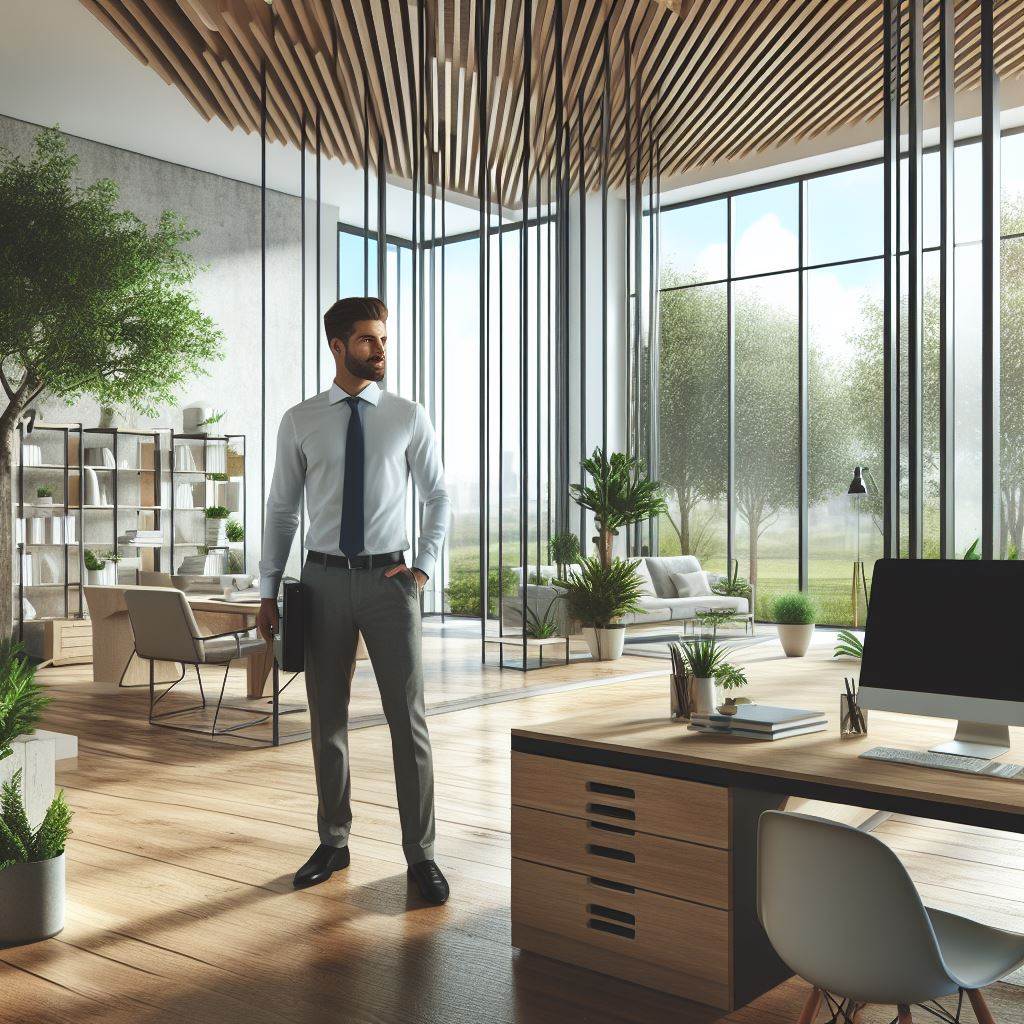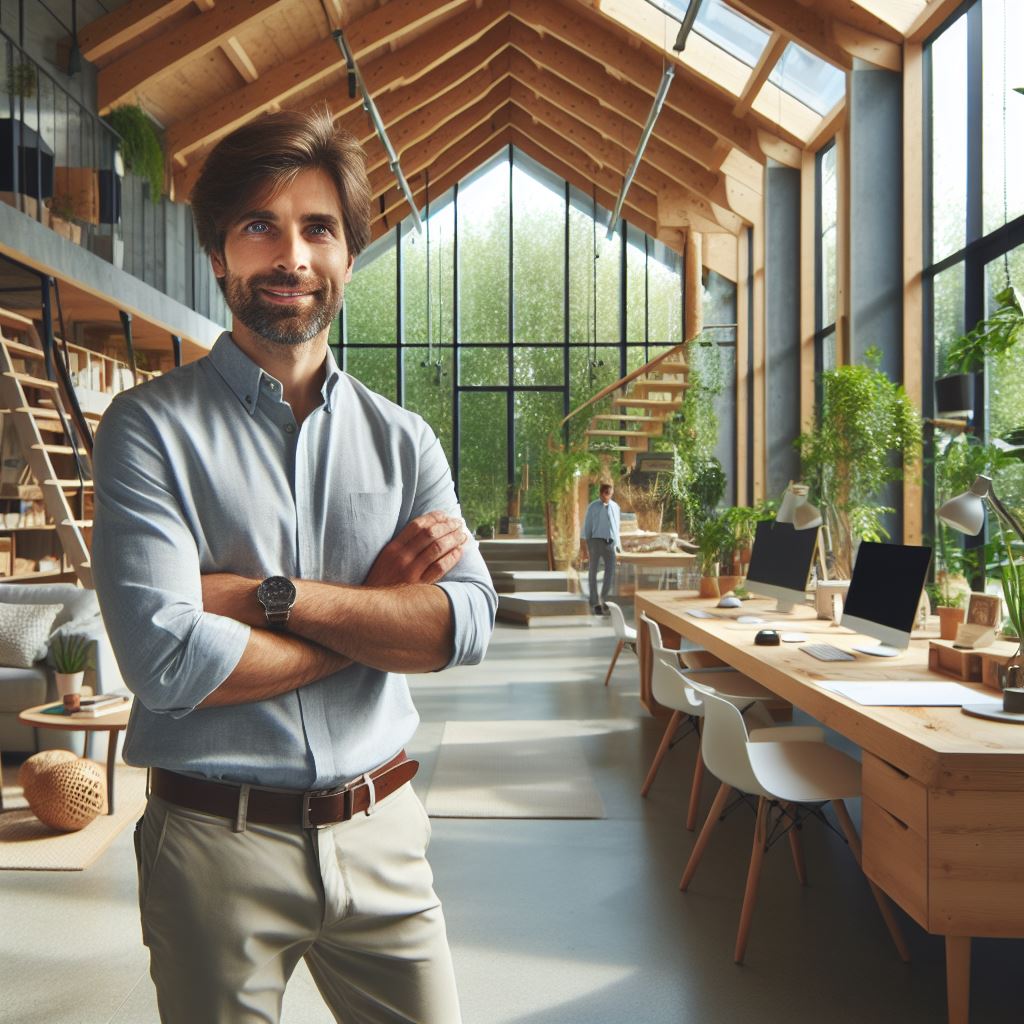Introduction
The purpose of this blog post is to delve into emerging office design trends anticipated in 2024.
As we approach the new year, staying abreast of evolving trends becomes pivotal for shaping future workspaces.
Enhanced flexibility will be a priority, accommodating diverse work styles and preferences.
Nature-inspired spaces, following biophilic design, will continue to enhance well-being in offices.
Smart integration of technology will revolutionize workspaces, fostering connectivity and improving efficiency.
A significant focus on health and wellness will be evident through features promoting physical and mental well-being.
Collaborative zones will gain prominence, fostering teamwork and innovation.
Sustainability principles will drive eco-friendly designs, aiming to reduce environmental footprints.
The rise of remote work will lead to the design of hybrid workplaces, accommodating both in-person and virtual collaboration.
Adaptive furniture, personalized workspaces, and ergonomic designs will be pivotal in enhancing employee comfort and creativity.
Ultimately, the office design trends of 2024 will be characterized by flexibility, nature-inspired spaces, smart technology integration.
And a strong emphasis on health and well-being, with collaboration, sustainability, personalization, and ergonomics playing significant roles.
Technological Advancements in Office Design
In the ever-evolving world of office design, technology plays a crucial role in shaping the future.
As we look forward to 2024, several technological advancements are expected to revolutionize office spaces. From artificial intelligence to virtual and augmented reality, let’s explore the exciting trends that await us.
Integration of artificial intelligence
- AI-powered assistants and smart automation.
- Personalized workplace experiences through AI.
Artificial intelligence (AI) has been making significant progress in recent years, and its integration into office design is set to transform the way we work.
- AI-powered assistants and smart automation: AI assistants, such as chatbots and voice-controlled devices, will become common in office settings. These assistants will streamline administrative tasks, respond to inquiries, and assist employees in their day-to-day activities.
- Personalized workplace experiences through AI: AI will enable workplaces to personalize experiences for employees. From personalized lighting and temperature settings to customized workstations, AI algorithms will understand individual preferences and create optimal working conditions.
These technological advancements will reshape the traditional office layout and bring new possibilities to enhance productivity and employee well-being.
Successful implementation will require organizations to embrace change and adapt their office designs accordingly.
AI integration will enable offices to become more efficient and responsive to individual employee needs.
With AI-powered assistants, mundane and time-consuming tasks can be automated, freeing up employees to focus on more complex and creative work.
Additionally, personalized workplace experiences will enhance employee satisfaction and productivity, as the office environment adapts to their preferences and requirements.
Virtual and augmented reality in office spaces
- Virtual collaboration and remote work.
- Augmented reality for enhanced workspace productivity.
The rise of virtual and augmented reality (VR/AR) has the potential to revolutionize office spaces, enabling immersive and collaborative experiences.
- Virtual collaboration and remote work: VR technology will allow employees to collaborate in virtual environments, overcoming geographical barriers. Remote work will become more engaging as virtual meetings and brainstorming sessions replicate the experience of face-to-face interactions.
- Augmented reality for enhanced workspace productivity: AR will enhance workspace productivity by overlaying digital information onto the physical environment. Through AR glasses, employees can access real-time data, instructions, and tutorials, enabling faster and more efficient task completion.
Virtual and augmented reality will break down physical barriers and provide new ways for teams to collaborate and work remotely.
Employees will no longer be limited by their location, as they can virtually meet and interact with colleagues from anywhere in the world.
This will not only expand the talent pool but also foster a more inclusive and diverse work environment.
Augmented reality, in particular, will transform the way employees interact with their workspace.
By seamlessly overlaying digital information onto the physical environment, AR glasses will enable employees to access real-time data and instructions, improving the accuracy and speed of task completion.
Training and onboarding processes will become more effective through interactive tutorials, reducing the learning curve for new employees.
All in all, office design in 2024 will be heavily influenced by technological advancements.
The integration of artificial intelligence and the adoption of virtual and augmented reality will unlock new possibilities for workplace efficiency, productivity, and collaboration.
As organizations embrace these trends, they will create innovative and dynamic office spaces that empower employees and boost overall business success.
Sustainability and Green Practices
In 2024, office design trends will continue to prioritize sustainability and green practices.
Incorporation of sustainable materials
- Office spaces will make use of recycled and eco-friendly resources for construction and furnishings.
- Sustainable lighting, HVAC systems, and furniture will play a key role in reducing energy consumption.
As the world becomes more conscious of the environmental impact of various industries, office design is also evolving to incorporate sustainable practices.
In 2024, the incorporation of sustainable materials will be a major trend in office design.
By using recycled and eco-friendly resources, office spaces will be able to minimize their carbon footprint.
The construction materials, furniture, and even office supplies will be carefully selected to ensure they are environmentally friendly.
This shift towards sustainable materials not only benefits the environment but also creates a healthier work environment for employees.
Another aspect that will contribute to sustainability in office design is the implementation of energy-efficient systems.
Lighting, HVAC (heating, ventilation, and air conditioning), and furniture will be designed with energy conservation in mind.
LED lighting will be widely used for its energy-saving properties, and smart HVAC systems will be utilized to optimize energy usage based on occupancy and temperature settings.
Biophilic design and its benefits
- Office spaces will integrate natural elements such as plants, natural light, and water features.
- This integration will lead to improved air quality and increase employee well-being and productivity.
Biophilic design, which focuses on incorporating natural elements into indoor spaces, will also gain prominence in office design.
In 2024, office spaces will be filled with lush greenery, natural light, and even water features.
These elements not only provide aesthetic value but also have numerous benefits for employees.
Integration of natural elements in office spaces has proven to enhance air quality, reduce stress, and improve employee well-being.
Plants act as natural air purifiers by filtering toxins and releasing oxygen.
Natural light has also been linked to increased productivity and better mental health among employees.
Including water features, such as indoor waterfalls or aquariums, can create a calming and soothing atmosphere, further enhancing employee well-being.
Most importantly, sustainability and green practices will greatly influence office design trends in 2024.
The incorporation of recycled and eco-friendly materials, energy-efficient systems, and biophilic design will create healthier and more environmentally conscious work environments.
These trends not only benefit the planet but also promote employee well-being and productivity.
As companies strive to create a positive impact and attract top talent, the adoption of sustainable office design will play a crucial role in achieving these goals.
In the year 2024, office design trends are evolving to meet the changing needs of the modern workforce. One major shift is towards flexible and agile workspaces that allow for collaboration and adaptability.
Read: Tech Impact on Commercial Properties

Flexible and Agile Workspaces
Open office layouts with modular furniture
- Open office layouts are becoming increasingly popular, promoting interaction and communication among employees.
- Modular furniture is being used to create flexible spaces that can be easily rearranged to suit different needs.
Overall, the shift towards flexible and agile workspaces in 2024 is driven by the recognition that a one-size-fits-all approach is no longer effective.
Employees have different work styles and preferences, and companies are realizing the importance of providing an environment that supports them.
Open office layouts with modular furniture are a great solution for creating collaborative and adaptable spaces.
They promote communication, teamwork, and flexibility. Employees can easily reconfigure their workstations to suit their changing needs and collaborate with their colleagues in designated collaborative zones.
Collaborative zones and flexible workstations
- Collaborative zones are being incorporated into office designs to encourage teamwork and brainstorming.
- Flexible workstations are becoming more common, allowing employees to choose the environment that best suits their tasks.
- Utilization of versatile furniture helps in creating these collaborative zones and flexible workstations effectively.
Activity-based work environments
- Companies are creating dedicated spaces for specific tasks, such as quiet rooms for focused work or brainstorming areas for creative thinking.
- These activity-based work environments cater to different types of work and provide employees with the right atmosphere to be productive.
- Support for various working styles and preferences is a key aspect of activity-based work environments.
Companies increasingly adopt versatile work environments, recognizing varied tasks demand different settings.
Investment in specialized spaces, like quiet rooms or relaxation areas, emphasizes creating conducive environments for focused work, creative thinking, or informal discussions.
The integration of flexible furniture facilitates dynamic transformations, swiftly adapting spaces to diverse purposes.
This adaptability is crucial in crafting workspaces that cater to the diverse needs of employees.
Embracing flexibility and agility, companies in 2024 cultivate environments fostering collaboration and accommodating varied work styles.
The emphasis on dynamic workspaces empowers employees to choose settings that enhance productivity and creativity.
Ultimately, the prevailing office design trends in 2024 revolve around flexibility and agility, marked by open layouts, modular furniture, and activity-based workspaces.
This intentional approach, providing employees with suitable spaces and furniture, fuels environments that not only boost productivity but also encourage collaboration and elevate employee satisfaction.
Read: Green Buildings: Future of Offices?
Emphasis on Employee Well-being
In the year 2024, office design trends will continue to prioritize the well-being of employees.
Companies are increasingly recognizing the importance of creating a healthy and inspiring work environment to boost productivity and satisfaction among their workforce.
Several key elements will be emphasized in office design to fulfill this objective.
Wellness rooms and spaces
One of the primary focuses in office design in 2024 will be creating dedicated wellness rooms and spaces.
These areas will provide employees with a tranquil environment where they can unwind and take care of their well-being.
Meditation and relaxation areas
Office spaces will incorporate designated meditation and relaxation areas to promote mental clarity and stress reduction.
These spaces will feature comfortable seating, calming decor, and possibly even light therapy devices.
Encouraging physical activity and exercise
Recognizing the importance of physical health, office designs in 2024 will also include spaces that encourage physical activity and exercise.
These areas could feature gym equipment, yoga mats, and activities that employees can partake in during their break time.
Incorporation of natural light and biodynamic lighting
In 2024, office designs will increasingly prioritize the use of natural light and biodynamic lighting systems to improve employee well-being.
Promotion of circadian rhythm and productivity
Natural light and biodynamic lighting will be strategically integrated into office spaces to regulate employees’ circadian rhythm.
Exposure to natural light helps maintain a healthy sleep-wake cycle, leading to improved productivity and overall well-being.
Reduction of eye strain and fatigue
Incorporating natural light and biodynamic lighting systems will also reduce eye strain and fatigue among employees.
These lighting solutions will mimic natural sunlight, providing a more comfortable and energizing work environment.
In summary, office design trends in 2024 will strongly emphasize the well-being of employees.
Incorporating wellness rooms and spaces, including meditation and relaxation areas, as well as encouraging physical activity, will contribute to a healthier and more balanced workforce.
Additionally, the incorporation of natural light and biodynamic lighting systems will positively impact employees’ circadian rhythm, productivity, and reduce eye strain and fatigue.
By prioritizing employee well-being in office design, companies can create a more harmonious and productive workplace.
Read: US Retail Spaces: Evolution & Trends
Inclusive and Diverse Office Settings
Design considerations for different abilities
- Wheelchair accessibility and ergonomic furniture
- Sensory-friendly spaces for neurodiverse individuals
Creating inclusive and diverse office settings goes beyond promoting equality; it enhances productivity and fosters a positive work environment.
In 2024, office design trends will prioritize accessibility and inclusivity, considering the needs of individuals with varying abilities.
Wheelchair accessibility and ergonomic furniture
Efforts to ensure wheelchair accessibility in office spaces will be crucial.
Ramps and elevators will allow easy movement throughout the workspace, and doorways will be wide enough to accommodate wheelchair users.
Moreover, ergonomic furniture will be introduced to enhance comfort and support for individuals with mobility challenges.
Workstations and desks will be adjustable to accommodate different heights, providing flexibility and ease for wheelchair users.
Additionally, specialized seating options, such as chairs with built-in lumbar support and padding, will create a more comfortable and inclusive atmosphere.
Sensory-friendly spaces for neurodiverse individuals
The importance of sensory-friendly spaces will be recognized to cater to neurodiverse individuals in the workplace.
Sensory rooms equipped with dimmable lighting, noise-canceling features, and calming elements will allow employees with autism or sensory processing disorders to feel more comfortable and focused.
Integrating nature-inspired designs, such as indoor plants or water features, can also create a soothing environment.
Providing areas for relaxation or meditation will promote a healthy work-life balance for all employees, addressing their diverse needs.
Cultural and spatial inclusivity
- Breaking down barriers and encouraging collaboration
- Celebrating diversity through design aesthetics
Aside from physical accessibility, inclusivity in office design will also emphasize cultural and spatial aspects to create a welcoming atmosphere for employees from diverse backgrounds.
Breaking down barriers and encouraging collaboration
In 2024, office layouts will be designed to foster collaboration while minimizing barriers.
Open-plan workspaces will accommodate different work styles and encourage interaction among colleagues. The removal of physical barriers, such as cubicle walls, will promote transparency and teamwork.
A well-designed breakout area or common space will serve as a hub for informal meetings, brainstorming sessions, and social interactions among employees.
These shared spaces will be versatile and adaptable, allowing employees to connect and collaborate across teams and departments.
Celebrating diversity through design aesthetics
The importance of sensory-friendly spaces will be recognized to cater to neurodiverse individuals in the workplace.
Sensory rooms equipped with dimmable lighting, noise-canceling features, and calming elements will allow employees with autism or sensory processing disorders to feel more comfortable and focused.
Integrating nature-inspired designs, such as indoor plants or water features, can also createOffice design aesthetics will also play a significant role in celebrating cultural diversity and fostering a sense of belonging.
Wall art, murals, or installations that represent different cultures, ethnicities, and traditions will be incorporated into office spaces.
A diverse color palette, with vibrant and eclectic combinations, will be used to create an inclusive and visually stimulating environment.
Moreover, the inclusion of cultural artifacts and symbols from various communities will further emphasize the celebration of diversity.
Therefore , office design trends in 2024 will prioritize inclusive and diverse settings.
Design considerations will revolve around accessibility for individuals with different abilities, including wheelchair users and neurodiverse individuals.
Moreover, cultural and spatial inclusivity will be embraced to break down barriers, encourage collaboration, and celebrate diversity.
By creating such environments, companies can cultivate a more productive, creative, and harmonious workforce. a soothing environment.
Providing areas for relaxation or meditation will promote a healthy work-life balance for all employees, addressing their diverse needs.
Read: Retail Property Outlook: A 2024 Review
Conclusion
As we conclude our exploration of the dynamic landscape of office design trends in 2024, the tapestry unfurls with open layouts fostering collaboration, modular furniture promoting adaptability, and the advent of activity-based workspaces catering to diverse work styles.
The importance of adapting to these evolving workplace needs resonates strongly.
This isn’t merely a shift in aesthetics; it’s a strategic response to the changing dynamics of how we work.
Recognizing and embracing these trends is fundamental to enhancing productivity, fostering employee satisfaction, and creating work environments that resonate with the contemporary workforce.
As the ever-evolving world of office design continues to unfold, the encouragement echoes—stay updated.
Explore the innovative realms of office design, be at the forefront of transformative changes.
And let the evolving landscape shape workplaces that not only meet the needs of today but anticipate the demands of tomorrow.
The journey into the future of office design is an invitation to reimagine, reinvent, and revolutionize the way we perceive and experience workspaces.




